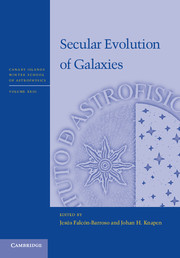Book contents
- Frontmatter
- Contents
- List of contributors
- Participants
- Preface
- Acknowledgments
- Secular evolution in disk galaxies
- Galaxy morphology
- Dynamics of secular evolution
- Bars and secular evolution in disk galaxies: Theoretical input
- Stellar populations
- Star formation rate indicators
- The evolving interstellar medium
- Evolution of star formation and gas
- Cosmological evolution of galaxies
- References
Bars and secular evolution in disk galaxies: Theoretical input
Published online by Cambridge University Press: 05 September 2013
- Frontmatter
- Contents
- List of contributors
- Participants
- Preface
- Acknowledgments
- Secular evolution in disk galaxies
- Galaxy morphology
- Dynamics of secular evolution
- Bars and secular evolution in disk galaxies: Theoretical input
- Stellar populations
- Star formation rate indicators
- The evolving interstellar medium
- Evolution of star formation and gas
- Cosmological evolution of galaxies
- References
Summary
Abstract
Bars play a major role in driving the evolution of disk galaxies and in shaping their present properties. They cause angular momentum to be redistributed within the galaxy, emitted mainly from (near-)resonant material at the inner Lindblad resonance of the bar, and absorbed mainly by (near-)resonant material in the spheroid (i.e., the halo and, whenever relevant, the bulge) and in the outer disk. Spheroids delay and slow down the initial growth of the bar they host, but, at the later stages of the evolution, they strengthen the bar by absorbing angular momentum. Increased velocity dispersion in the (near-)resonant regions delays bar formation and leads to less strong bars.
When bars form they are vertically thin, but soon their inner parts puff up and form what is commonly known as the boxy/peanut bulge. This gives a complex and interesting shape to the bar which explains a number of observations and also argues that the COBE/DIRBE bar and the Long bar in our Galaxy are, respectively, the thin and the thick part of a single bar.
The value of the bar pattern speed may be set by optimising the balance between emitters and absorbers, so that a maximum amount of angular momentum is redistributed. As they evolve, bars grow stronger and rotate slower. Bars also redistribute matter within the galaxy, create a disky bulge (pseudo-bulge), increase the disk scale-length and extent and drive substructures such as spirals and rings.
- Type
- Chapter
- Information
- Secular Evolution of Galaxies , pp. 305 - 352Publisher: Cambridge University PressPrint publication year: 2013
References
- 77
- Cited by

